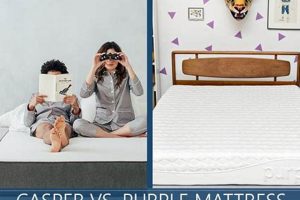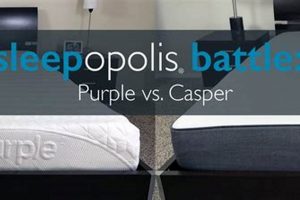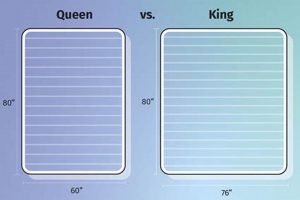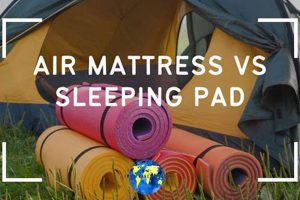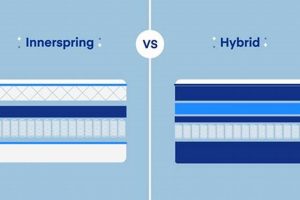The subject concerns two prevalent types of mattresses distinguished by their core materials and resulting performance characteristics. One incorporates a viscoelastic polymer known for its conforming properties, while the other integrates a cooling agent within its structure, often the same viscoelastic polymer. These design choices impact factors such as heat retention, pressure relief, and overall comfort.
Understanding the distinctions between these sleeping surfaces is crucial for individuals seeking optimal sleep quality. The material compositions directly influence spinal alignment, temperature regulation, and motion isolation, factors that contribute significantly to a restful night. Historically, advancements in material science have driven innovations in mattress design, addressing concerns regarding heat build-up and discomfort.
The ensuing discussion will delve into a comparative analysis of these two mattress types. Key aspects to be examined include their construction, performance regarding temperature neutrality, pressure relief capabilities, support characteristics, durability, and price point. This detailed comparison aims to equip consumers with the knowledge necessary to make an informed decision based on their individual needs and preferences.
Selecting Between Gel and Viscoelastic Mattresses
The selection process requires careful evaluation of individual sleep preferences and specific needs. Understanding the inherent characteristics of each mattress type is crucial for maximizing sleep quality and overall well-being.
Tip 1: Assess Temperature Sensitivity: Individuals prone to overheating during sleep should prioritize mattresses incorporating gel-infused layers. The gel aims to dissipate body heat, promoting a cooler sleep environment. Conversely, standard viscoelastic formulations tend to retain heat, potentially leading to discomfort.
Tip 2: Evaluate Pressure Relief Requirements: Viscoelastic mattresses are generally recognized for their superior contouring abilities, effectively distributing body weight and alleviating pressure points. This is particularly beneficial for individuals experiencing joint pain or back discomfort. Gel-infused variations provide a similar level of pressure relief, though the degree may vary depending on the gel concentration and density.
Tip 3: Consider Support Needs and Sleeping Position: Different sleeping positions necessitate varying levels of support. Side sleepers often benefit from the conforming nature of viscoelastic formulations, while back and stomach sleepers may require a firmer surface to maintain proper spinal alignment. Evaluate the core support system of both mattress types to ensure adequate support for the preferred sleep posture.
Tip 4: Investigate Mattress Construction and Materials: The overall composition of the mattress significantly impacts its durability and performance. Pay close attention to the quality of the foam layers, the type of gel used (if applicable), and the construction of the support core. Higher-density materials generally offer greater longevity and resistance to sagging.
Tip 5: Compare Motion Isolation Capabilities: Viscoelastic mattresses excel at isolating motion, minimizing disturbances caused by a partner’s movements during sleep. Gel-infused varieties typically offer comparable motion isolation performance. This is a particularly important consideration for individuals sharing a bed.
Tip 6: Research Warranty and Trial Periods: Prior to making a purchase, thoroughly review the manufacturer’s warranty and trial period policies. These provisions provide an opportunity to assess the mattress’s suitability and ensure satisfaction with its performance. A generous trial period allows for a risk-free evaluation of the mattress’s comfort and support characteristics.
Tip 7: Analyze Pricing and Budgetary Constraints: Prices vary considerably between different brands and models. Viscoelastic mattresses, particularly those incorporating advanced features or higher-quality materials, tend to be more expensive than conventional innerspring mattresses. Gel-infused versions may command a premium due to the added cooling technology. Establish a realistic budget and compare prices across various retailers to identify the most cost-effective option.
Careful consideration of these factors will aid in selecting a mattress that aligns with individual preferences and sleep requirements, ultimately contributing to improved sleep quality and overall well-being.
The subsequent sections will present a conclusive summary, reinforcing the key distinctions between these mattresses.
1. Temperature Regulation
Temperature regulation represents a primary differentiator. Traditional viscoelastic material possesses inherent insulating properties that can lead to heat retention, potentially causing discomfort for some sleepers. In response to this issue, manufacturers incorporated gel infusions designed to mitigate heat build-up. Gel, in its various forms (beads, swirls, or layers), aims to absorb and dissipate body heat, creating a cooler sleep environment. The efficacy of this feature depends largely on the type and concentration of gel used, as well as the overall mattress construction. For example, a mattress with a thin layer of low-density gel may offer minimal cooling benefits, while a mattress featuring a thick layer of high-density, phase-change gel could provide substantial temperature regulation.
The practical significance of effective temperature regulation extends beyond mere comfort. Maintaining a stable body temperature throughout the night has been linked to improved sleep quality, reduced tossing and turning, and a greater likelihood of reaching deeper sleep stages. Individuals experiencing night sweats or living in warmer climates may find gel-infused mattresses particularly beneficial. However, it’s crucial to acknowledge that individual experiences can vary. Factors such as bedding material, room temperature, and personal physiology can all influence the perception of temperature while sleeping. Some individuals may find that even mattresses with gel infusions still retain more heat than desired, while others may experience sufficient cooling to enhance their sleep quality.
In summary, the incorporation of gel into viscoelastic formulations represents a deliberate attempt to address the issue of heat retention. While the effectiveness of gel-infused mattresses in promoting temperature regulation is generally acknowledged, its impact is nuanced and influenced by various factors. Consumers should carefully consider their individual temperature preferences and environmental conditions when evaluating the potential benefits of this technology. Therefore, it is important to assess all characteristics of these mattresses when choosing your sleep surface.
2. Pressure Relief
Pressure relief is a critical factor in mattress selection, directly impacting sleep quality and physical well-being. Viscoelastic mattresses, including those with gel infusions, are often chosen for their ability to conform to the body’s contours, distributing weight and alleviating pressure points. The effectiveness of pressure relief, however, can vary significantly between the two.
- Conforming Ability of Viscoelastic Material
The fundamental property of viscoelastic foam is its ability to mold to the shape of the body under pressure. This conforming action reduces stress on areas such as the hips, shoulders, and spine. For individuals with joint pain or back problems, this characteristic is often a primary consideration. The extent of conforming ability depends on the foam’s density and indentation load deflection (ILD) rating.
- Impact of Gel Infusions on Conformability
While gel infusions primarily address temperature regulation, they can also subtly influence the conforming properties of the mattress. Some gel formulations may slightly reduce the overall conforming ability compared to pure viscoelastic foam. Conversely, other gel materials, particularly those with a more fluid-like consistency, might enhance contouring. The specific impact depends on the type and distribution of the gel within the mattress.
- Zoned Support Systems and Targeted Pressure Relief
Many mattresses, both gel-infused and traditional viscoelastic, incorporate zoned support systems. These systems feature varying foam densities in different areas of the mattress, providing targeted support and pressure relief to specific body regions. For example, a softer zone may be present in the shoulder area to accommodate side sleeping, while a firmer zone supports the lumbar region. Zoned support can enhance the overall pressure relief performance regardless of the presence of gel infusions.
- Density and its Influence on Pressure Distribution
The density of the viscoelastic foam significantly affects its ability to distribute pressure evenly. Higher-density foams generally offer greater support and more effective pressure relief compared to lower-density foams. While gel infusions can contribute to the overall feel of the mattress, the underlying foam density remains a crucial determinant of its pressure-relieving capabilities. A mattress with high-density viscoelastic foam, regardless of gel infusion, will generally provide superior pressure relief compared to a low-density option.
The interplay between viscoelastic properties, gel infusions, zoned support systems, and foam density ultimately dictates the pressure relief performance of a mattress. Consumers should consider their individual needs and preferences, evaluating how these factors contribute to overall comfort and support. Direct comparison of different mattress models is recommended to determine the optimal balance of these features for achieving adequate pressure relief and improved sleep quality.
3. Motion Isolation
Motion isolation, the ability of a mattress to minimize the transfer of movement from one area to another, is a crucial consideration for couples or individuals sharing a bed. The degree to which a mattress effectively isolates motion can significantly impact sleep quality, particularly if one partner is restless or frequently changes position during the night. The material composition, especially in the context of mattresses featuring viscoelastic foam and gel infusions, plays a pivotal role in determining motion isolation capabilities.
- Viscoelastic Foam’s Intrinsic Damping Properties
Viscoelastic foam, due to its unique molecular structure, possesses inherent damping properties. This means that the material absorbs energy rather than transmitting it readily. When pressure is applied to one area of a viscoelastic mattress, the foam compresses locally, dissipating the force and minimizing disturbance to other areas. This characteristic contributes significantly to effective motion isolation. A higher-density viscoelastic foam generally exhibits superior damping capabilities compared to a lower-density foam.
- Impact of Gel Infusions on Motion Transfer
The presence of gel infusions can subtly influence the motion isolation performance of a viscoelastic mattress. The effect depends on the type, density, and distribution of the gel. Some gel formulations may slightly increase motion transfer, while others have a negligible impact or even enhance isolation. For instance, a mattress with a continuous layer of gel-infused foam may exhibit slightly better motion isolation compared to one with gel beads dispersed throughout the foam.
- The Role of Mattress Construction and Layering
Mattress construction significantly influences motion isolation. A mattress with multiple layers of different densities and compositions can effectively dampen motion transfer. For example, a viscoelastic comfort layer combined with a high-density support core can provide excellent motion isolation. The arrangement and thickness of these layers play a crucial role in minimizing disturbances. Mattresses with individually wrapped coils in the support core, in addition to a viscoelastic comfort layer, may also provide exceptional motion isolation.
- Edge Support and Motion Containment
The firmness and construction of the mattress edge contribute to overall motion isolation. Weak edge support can lead to increased motion transfer, especially near the perimeter of the bed. A reinforced edge, often achieved through the use of high-density foam or steel coils, can contain motion and prevent it from spreading across the entire mattress surface. Effective edge support is particularly important for individuals who sleep near the edge of the bed or frequently sit on the edge.
In summary, the ability to effectively isolate motion in mattresses incorporating viscoelastic foam and gel infusions is a multifaceted characteristic influenced by material properties, construction techniques, and design elements. While viscoelastic foam inherently possesses damping capabilities, the specific gel formulation, layering configuration, and edge support contribute significantly to the overall performance. Evaluating these factors enables consumers to make informed decisions based on their individual needs and preferences, leading to improved sleep quality and reduced disturbance for partners sharing a bed. The optimal choice depends on a careful consideration of these interacting features within the selected mattress design.
4. Supportiveness
Supportiveness, in the context of mattresses, refers to the ability of the sleeping surface to maintain proper spinal alignment and distribute body weight evenly. This attribute directly impacts comfort, reduces pressure points, and minimizes the risk of back pain. The underlying materials and construction of mattresses, specifically those employing viscoelastic foam (often referred to as memory foam) and gel infusions, critically determine their supportiveness.
- Core Density and Resistance to Compression
The density of the underlying foam layers significantly dictates the mattress’s ability to resist compression and provide consistent support over time. Higher-density foams offer greater resistance, preventing excessive sinking and maintaining spinal alignment, particularly for heavier individuals. Gel infusions, while primarily intended for temperature regulation, can influence the overall firmness and, consequently, the support characteristics. A mattress with a high-density viscoelastic core, irrespective of gel infusion, typically provides superior support compared to a low-density counterpart.
- Zoned Support Systems and Targeted Spinal Alignment
Many mattresses incorporate zoned support systems, utilizing varying foam densities in different areas to address the specific support needs of different body regions. Softer zones may accommodate the shoulders and hips, while firmer zones support the lumbar region. This targeted approach promotes optimal spinal alignment, irrespective of the sleeping position. The effectiveness of zoned support depends on the precision of the zoning and the quality of the materials used. Both viscoelastic and gel-infused mattresses can incorporate zoned support systems, but their performance hinges on the design and implementation.
- Edge Support Construction and Usable Surface Area
The construction of the mattress edge directly affects the usable sleeping surface and the stability of the mattress. Reinforced edges, often achieved through the use of high-density foam or steel coils, prevent sagging and provide a stable surface for sitting or sleeping near the perimeter. Weak edge support can compromise spinal alignment and reduce the overall comfort of the mattress. The presence or absence of gel infusions does not directly influence edge support; rather, it depends on the materials and construction techniques employed in the edge region of the mattress.
- Firmness Levels and Accommodation of Sleeping Positions
Mattress firmness, ranging from plush to firm, affects the perceived support and suitability for different sleeping positions. Side sleepers often benefit from softer mattresses that conform to the body’s contours, while back and stomach sleepers typically require firmer surfaces to maintain spinal alignment. Viscoelastic foam and gel-infused mattresses are available in a range of firmness levels to accommodate diverse preferences. The choice of firmness should align with individual sleep habits and body weight to ensure adequate support and comfort.
The supportiveness of a mattress featuring either viscoelastic foam or gel infusions is a complex interplay of material density, zoned construction, edge support, and firmness levels. While gel infusions primarily address temperature regulation, they can subtly influence the overall feel and perceived support. The optimal choice hinges on individual needs and preferences, requiring careful consideration of these interconnected factors and, ideally, in-person testing to assess suitability.
5. Material Density
Material density, measured in pounds per cubic foot (PCF), exerts a significant influence on the performance and longevity of both viscoelastic and gel-infused viscoelastic mattresses. A higher density generally correlates with enhanced durability, improved support, and greater resistance to body impressions over time. In the context of viscoelastic mattresses, a denser foam provides better contouring and pressure relief, adapting more effectively to the body’s shape. For example, a 5 PCF viscoelastic mattress will generally offer superior support and last longer than a 3 PCF mattress, all other factors being equal. Gel-infused mattresses also benefit from higher density, as it provides a more stable matrix for the gel particles or layers, preventing premature degradation and ensuring consistent temperature regulation. Without sufficient density in the underlying viscoelastic, the gel’s cooling properties may be short-lived or unevenly distributed.
The practical implications of material density extend to the overall user experience. A low-density mattress, regardless of the presence of gel, is more susceptible to sagging and compression, leading to discomfort and potential back pain. This is particularly relevant for heavier individuals or couples. Conversely, a higher-density mattress maintains its shape and supportiveness for a longer period, providing a more consistent and comfortable sleep surface. Consider the scenario of a side sleeper: a higher-density viscoelastic mattress will allow the shoulder to sink in sufficiently for spinal alignment without bottoming out, whereas a low-density mattress may collapse entirely, resulting in shoulder pain and misalignment. In gel-infused models, adequate density ensures uniform gel distribution and prevents the formation of hot spots due to uneven compression.
In summary, material density is a crucial determinant of both the performance and lifespan of viscoelastic and gel-infused viscoelastic mattresses. While gel infusions contribute to temperature regulation, the underlying density of the viscoelastic foam dictates its support, durability, and resistance to body impressions. Consumers should prioritize mattresses with higher densities to ensure long-term comfort, proper spinal alignment, and a more consistent sleep experience. Neglecting density in favor of superficial features, such as gel infusion alone, may result in a premature loss of support and a diminished overall value proposition.
6. Longevity
The lifespan of a mattress directly correlates with its material composition and construction quality. Regarding the dichotomy of gel-infused and standard viscoelastic options, longevity is determined by the inherent properties of the core materials and the presence, type, and distribution of the gel. Inherent breakdown of the viscoelastic material itself, due to constant compression and decompression cycles, represents a primary factor limiting mattress lifespan. Additionally, the structural integrity of the gel component, its resistance to degradation, and its capacity to maintain uniform distribution all impact overall product longevity. A mattress constructed with high-density viscoelastic foam and a durable, evenly distributed gel infusion is expected to exhibit greater longevity than a comparable model utilizing lower-density foam or a less stable gel. Premature sagging, uneven support, and diminished cooling effectiveness are common indicators of compromised longevity.
The integration of gel into the viscoelastic structure introduces both potential benefits and challenges concerning lifespan. On one hand, certain gel formulations might improve airflow and reduce moisture accumulation, mitigating microbial growth and material degradation. On the other hand, the introduction of a foreign material can create points of weakness within the foam matrix, potentially accelerating breakdown under stress. Real-world examples demonstrate this variability; mattresses utilizing high-quality, high-density gel often maintain structural integrity and cooling performance for extended periods, while those employing lower-quality gel or uneven distribution strategies tend to degrade more rapidly. This degradation can manifest as a loss of cooling sensation or a noticeable change in the overall feel and support provided by the mattress, requiring premature replacement. The presence of off-gassing, if it persists for a prolonged duration, can also negatively impact the perceived quality and long-term comfort of the mattress.
Ultimately, the longevity of a gel-infused or standard viscoelastic mattress hinges on a delicate balance of material quality, construction techniques, and usage patterns. While gel infusions can enhance initial comfort and temperature regulation, their long-term impact depends on their inherent stability and their integration within a durable viscoelastic matrix. Consumers should carefully evaluate material specifications, construction details, and warranty provisions to make informed decisions regarding mattress selection, prioritizing longevity as a key component of overall value and satisfaction. The long-term structural integrity and functional performance directly determine the value proposition, necessitating thorough research and informed decision-making.
7. Cost
The price point of a sleeping surface is a significant factor in purchasing decisions. Within the realm of viscoelastic mattresses, gel-infused models generally command a premium compared to their standard counterparts. This price differential stems from the added materials and manufacturing processes required to integrate the cooling gel. The specific type and concentration of gel used, as well as the complexity of the infusion method, directly impact the final cost. For example, mattresses employing advanced phase-change materials within the gel tend to be more expensive than those using simpler gel bead infusions. The cause-and-effect relationship is clear: added functionality increases production complexity and, subsequently, the retail price. Cost, therefore, becomes a critical component in the evaluation of these mattresses, influencing consumer accessibility and value perception.
However, the upfront cost does not represent the complete picture. A higher initial investment in a gel-infused mattress may translate to long-term savings. The cooling properties can reduce the need for additional temperature-regulating accessories, such as specialized sheets or cooling blankets. Moreover, the potential for improved sleep quality can reduce healthcare costs associated with sleep deprivation. A consumer choosing between a standard viscoelastic mattress at $500 and a gel-infused version at $800 must weigh these potential long-term benefits against the immediate price difference. It is also crucial to consider the potential lifespan of each mattress. A more expensive, higher-quality option may outlast a cheaper alternative, further influencing the overall cost-effectiveness. Therefore, the true cost assessment requires a holistic approach, encompassing initial price, potential long-term benefits, and projected lifespan.
In summary, the cost associated with both standard and gel-infused viscoelastic mattresses extends beyond the initial purchase price. While gel-infused models typically carry a premium due to added materials and manufacturing complexity, the potential for long-term savings through reduced need for accessories and improved sleep quality must be considered. A comprehensive evaluation should encompass material quality, construction techniques, and warranty provisions to accurately assess the overall value proposition and ensure that the chosen mattress aligns with budgetary constraints and individual needs. Failure to consider the long-term implications of cost can lead to a false economy and dissatisfaction with the purchase.
Frequently Asked Questions
The following section addresses common inquiries regarding the distinctions and applications of gel-infused and standard viscoelastic mattresses. The intent is to provide clarity on frequently encountered concerns and misconceptions.
Question 1: Does a gel-infused viscoelastic mattress inherently sleep cooler than a standard viscoelastic mattress?
While gel infusions are designed to mitigate heat retention, the extent of cooling depends on the type and concentration of gel, as well as overall mattress construction. Not all gel-infused mattresses provide significant cooling benefits. High-density, phase-change gel is generally more effective than simple gel bead infusions.
Question 2: Is viscoelastic foam density more important than gel infusion for mattress longevity?
Yes. While gel infusions can influence comfort, the underlying density of the viscoelastic foam is paramount for durability. A higher-density foam resists compression and sagging, extending the mattress’s lifespan. Without adequate foam density, gel infusions will not compensate for premature material breakdown.
Question 3: Do all viscoelastic mattresses provide the same level of pressure relief?
No. Pressure relief depends on the foam’s density, ILD rating, and the presence of zoned support systems. Higher-density foams typically offer superior pressure relief. Zoned support systems tailor the mattress’s firmness to different body regions, optimizing pressure distribution.
Question 4: How does edge support influence motion isolation in these types of mattresses?
Weak edge support can compromise motion isolation, particularly near the perimeter of the bed. A reinforced edge, using high-density foam or steel coils, prevents motion transfer and expands the usable sleeping surface.
Question 5: Are gel-infused viscoelastic mattresses always more expensive than standard viscoelastic mattresses?
Generally, yes. The addition of gel materials and the associated manufacturing processes increase production costs, resulting in a higher retail price. However, the long-term benefits, such as reduced need for cooling accessories, should be considered.
Question 6: Is a trial period necessary when purchasing a gel-infused or standard viscoelastic mattress?
A trial period is highly recommended. Individual preferences and body types vary significantly. A trial period allows for assessment of comfort, support, and temperature regulation within a home environment, ensuring satisfaction before committing to the purchase.
These FAQs address critical aspects of “gel mattress vs memory foam,” emphasizing the interplay of materials, construction, and individual needs. Thorough research and careful consideration of these factors are essential for making an informed purchase decision.
The following section provides concluding remarks summarizing the key insights gained from this comprehensive analysis.
Gel Mattress vs Memory Foam
The preceding discussion dissected the attributes differentiating gel-infused and standard viscoelastic mattresses, clarifying key distinctions in temperature regulation, pressure relief, motion isolation, supportiveness, material density, longevity, and cost. The analysis underscored that while gel infusions can enhance thermal management, the underlying viscoelastic density and construction techniques exert a more significant influence on long-term performance and durability. The relative merits of each option depend heavily on individual sleep preferences and budgetary considerations.
Ultimately, selecting the optimal sleep surface necessitates a comprehensive evaluation of individual needs, coupled with diligent research into material specifications and construction details. The long-term implications of this decision extend beyond mere comfort, impacting sleep quality, physical well-being, and overall value. Prudent consumers will prioritize informed decision-making to maximize the benefits and minimize the potential drawbacks associated with either gel-infused or standard viscoelastic mattresses.


